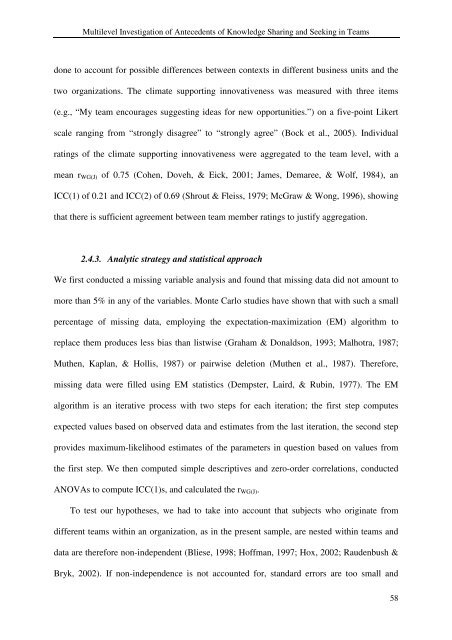thesis_Daniela Noethen_print final - Jacobs University
thesis_Daniela Noethen_print final - Jacobs University
thesis_Daniela Noethen_print final - Jacobs University
You also want an ePaper? Increase the reach of your titles
YUMPU automatically turns print PDFs into web optimized ePapers that Google loves.
Multilevel Investigation of Antecedents of Knowledge Sharing and Seeking in Teams<br />
done to account for possible differences between contexts in different business units and the<br />
two organizations. The climate supporting innovativeness was measured with three items<br />
(e.g., “My team encourages suggesting ideas for new opportunities.”) on a five-point Likert<br />
scale ranging from “strongly disagree” to “strongly agree” (Bock et al., 2005). Individual<br />
ratings of the climate supporting innovativeness were aggregated to the team level, with a<br />
mean r WG(J) of 0.75 (Cohen, Doveh, & Eick, 2001; James, Demaree, & Wolf, 1984), an<br />
ICC(1) of 0.21 and ICC(2) of 0.69 (Shrout & Fleiss, 1979; McGraw & Wong, 1996), showing<br />
that there is sufficient agreement between team member ratings to justify aggregation.<br />
2.4.3. Analytic strategy and statistical approach<br />
We first conducted a missing variable analysis and found that missing data did not amount to<br />
more than 5% in any of the variables. Monte Carlo studies have shown that with such a small<br />
percentage of missing data, employing the expectation-maximization (EM) algorithm to<br />
replace them produces less bias than listwise (Graham & Donaldson, 1993; Malhotra, 1987;<br />
Muthen, Kaplan, & Hollis, 1987) or pairwise deletion (Muthen et al., 1987). Therefore,<br />
missing data were filled using EM statistics (Dempster, Laird, & Rubin, 1977). The EM<br />
algorithm is an iterative process with two steps for each iteration; the first step computes<br />
expected values based on observed data and estimates from the last iteration, the second step<br />
provides maximum-likelihood estimates of the parameters in question based on values from<br />
the first step. We then computed simple descriptives and zero-order correlations, conducted<br />
ANOVAs to compute ICC(1)s, and calculated the r WG(J) .<br />
To test our hypotheses, we had to take into account that subjects who originate from<br />
different teams within an organization, as in the present sample, are nested within teams and<br />
data are therefore non-independent (Bliese, 1998; Hoffman, 1997; Hox, 2002; Raudenbush &<br />
Bryk, 2002). If non-independence is not accounted for, standard errors are too small and<br />
58

















